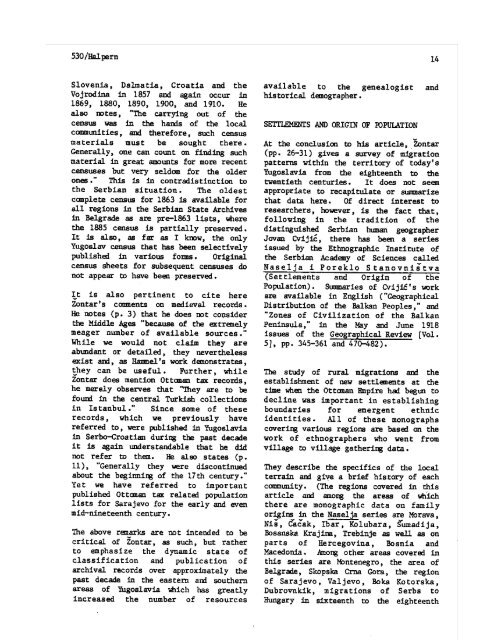Yugoslavia
Yugoslavia
Yugoslavia
You also want an ePaper? Increase the reach of your titles
YUMPU automatically turns print PDFs into web optimized ePapers that Google loves.
530/lla1pern<br />
Slovenia, Dalmatia, Croatia and the<br />
Vojrodina in 1857 and again occur in<br />
1869, 1880, 1890, 1900, and 1910. He<br />
also rotes, "The carrying out of the<br />
census was in the hands of the local<br />
communities, and therefore, such census<br />
materials must be sought there.<br />
Generally, one can COWlt on finding such<br />
material in great amoWlts for more recent<br />
censuses but very seldom for the older<br />
ones. This is in contradistinction to<br />
the Serbian situation. The oldest<br />
canplete census for 1863 is available for<br />
all regions in the Serbian State Archives<br />
in Belgrade as are pre-1863 lists, where<br />
the 1885 census is partially preserved.<br />
It is also, as far as I know, the only<br />
Yugoalav census that has been selectively<br />
published in various foIIDS. Original<br />
census sheets for subsequent censuses do<br />
not appear to have been preserved.<br />
It is also pertinent to cite here<br />
Zontar's coaments on medieval records.<br />
lie notes (p. 3) that he does rot cOllsider<br />
the Middle Ages "because of the extremely<br />
meager number of available sources."<br />
While we would not claim they are<br />
abundant or detailed, they nevertheless<br />
exist and, as Hamnel's work demonstrates,<br />
they can be useful. Further, while<br />
Zontar does mention Ottanan tax records,<br />
he merely observes that "They are to be<br />
foUId in the central Turkish collections<br />
in Istanbul ." Since some of these<br />
records, which we previously have<br />
referred to, were published in <strong>Yugoslavia</strong><br />
in Serbo-Croatisn duri'll the past decade<br />
it is again understandable that he did<br />
not refer to them. He also states (p.<br />
11), "Generally they were discontinued<br />
about the beginnilll of the 17th century."<br />
Yet we have referred to important<br />
published Ottanan tax related population<br />
lists for Sarajevo for the early and even<br />
mid-nineteenth century.<br />
The above remarks are not intended to be<br />
critical of Zontar, as such, but rather<br />
to emphasize the dynamic state of<br />
classification and publication of<br />
archival records over approximately the<br />
past decade in the eastern an:! southern<br />
areas of <strong>Yugoslavia</strong> which has greatly<br />
increased the number of resources<br />
available to the genealogist and<br />
historical demographer.<br />
SETILEMENrS AND ORIGIN OF RlPULATION<br />
At the conclusion to his article, Zontar<br />
(pp. 26-31) gives a survey of migration<br />
patterns within the territory of today's<br />
<strong>Yugoslavia</strong> from the eighteenth to the<br />
twentieth centuries. It does not seem<br />
appropriate to recapitulate or summarize<br />
that data here. Of direct interest to<br />
researchers, however, is the fact that,<br />
following in the tradition of the<br />
distinguished Serbian human geographer<br />
Jovan CvijiC, there has been a series<br />
issued by the Ethnographic Institute of<br />
the Serbian Academy of Sciences called<br />
Naselja i Poreklo Stanovnistva<br />
(Settlements and Origin of the<br />
Population). Summaries of Cvij:lC's work<br />
are available in English ("Geographical<br />
Distribution of the Balkan Peoples," and<br />
"Zones of Civilization of the Balkan<br />
Peninaula," in the May and June 1918<br />
issues of the Geographical Review [Vol.<br />
5], pp. 345-361 and 470-482).<br />
The study of rural migrations and the<br />
establishment of new settlements at the<br />
time when the Ottanan Elnpire ha:l begWl to<br />
decline was important in establishing<br />
boundaries for emergent ethnic<br />
identities. All of these monographs<br />
coveri'll various regions are based on the<br />
work of ethnographers who went from<br />
village to village gatheri'll data.<br />
They describe the specifics of the local<br />
terrain and give a brief history of each<br />
cOllllllWlity. (The regions covered in this<br />
article and am0'll the areas of which<br />
there are monographic data on family<br />
origins in the Naselja series are Morava,<br />
NiB, Cacak, Ibar, Kolubara, Sumadija,<br />
Bosanska Krajina, Trebinje as well as on<br />
parts of Hercegovina, Bosnia and<br />
Macedonia. hno'll other areas covered in<br />
this series are M:>ntenegro, the area of<br />
Belgrade, Skopska Cms Gore, the region<br />
of Sarajevo. Val j evo , Boka Kotorska,<br />
Dubrovnkik, migrations of Serbs to<br />
Hungary in sixteenth to the eighteenth<br />
14


